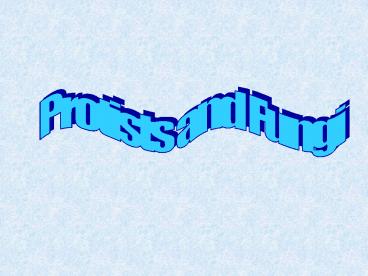Protists and Fungi - PowerPoint PPT Presentation
Title:
Protists and Fungi
Description:
Slide 1 – PowerPoint PPT presentation
Number of Views:766
Avg rating:3.0/5.0
Title: Protists and Fungi
1
Protists and Fungi
2
Characteristics of Kingdom Protista
- Most diverse group
- Eukaryotic cells
- Some autotrophs, some heterotrophs
- Unicellular and multicellular
3
Kingdom Protista Types
- Algae-Plant like Protists, autotrophs
- Protozoans-Animal like Protists, all unicellular,
heterotrophs - Fungus like Protists- move at some point in their
lives
4
Algae
- Classified by color
- Euglenoids
- Golden Algae
- Green Algae
- Brown Algae
- Red Algae
- Fire Algae
5
Euglenoids
- Autotrophic and heterotrophic
- Flagella- hunt like an animal
- Chloroplasts- make own food
- like plant
6
(No Transcript)
7
Golden Algae
Diatoms- two shells
8
More Diatoms
9
Green Algae
Unicellular and multicellular Contain
chlorophyll Plant ancestor Examples spirogyra,
ulva- sea lettuce, volvox- colonial algae
10
Green Algae
Spirogyra
11
Green Algae
12
Brown Algae
- Seaweed and kelp
- Has air bladder- gas-filled structures that keep
algae floating near the surface for photosynthesis
13
Red Algae
Feathery and fragile bodies Live in deep
oceans
14
Fire Algae
Dinoflagellates Bioluminescence- glow when
disturbed in the water
15
Fire Algae
- Red tide- uncontrolled growth (algal bloom) of
dinoflagellates. Release poisons that kill fish
16
Protozoans
- Classified by method of movement
- Rhizopods
- Ciliates
- Flagellates
- Sporozoans
17
Rhizopods
Amoeba
Move by pseudopodia- false feet- extends plasma
membrane around prey forming a pocket
18
Label the parts of the amoeba
- Contractile vacuole- used to pump out excess water
Nucleus
Plasma membrane
Contractile vacuole
Food particle engulfed by pseudopodia
Food vacuole
Pseudopodia
cytoplasm
19
Ciliates
Move by beating cilia
Stentor
Paramecium
20
Ciliates
Contractile Vacuole
Cilia
micronucleus
macronucleus
Oral groove
Anal pore
21
Flagellates
Move by flagella
Trypanasoma
22
Sporozoans
No method of movement Must live in food supply to
survive Many are parasitic
23
Fungus Like Protist
Plasmodium- colorful slime molds found oozing on
rotting logs in forests
Slime mold
24
Kingdom Fungi Review
- Classified by the shape of the structure that
holds the spores - Saprophytes- feed on dead matter
- Some parasites
- Stationary like plants/Heterotrophic like animals
- Absorb food through cell walls
25
Bread mold
Bread Mold-Rhizopus Sporangia
Black Mold -Stachybotris
26
Rhizopus- Bread Mold
spores
sporangium
sporangiophore
Hyphae
mycellium
27
Mushrooms
28
Mushroom development
gills
basidia
cap
spores
button
stipe
29
Yeast
important in brewing and baking, make Penicillium
30
Lichens
Fungus and algae Mutualistic relationship-algae
provides food and fungus provides protection and
moisture






























